Module 11 Body language模块基础练习题 2022-2023学年外研版七年级英语下册(含答案)
文档属性
| 名称 | Module 11 Body language模块基础练习题 2022-2023学年外研版七年级英语下册(含答案) | 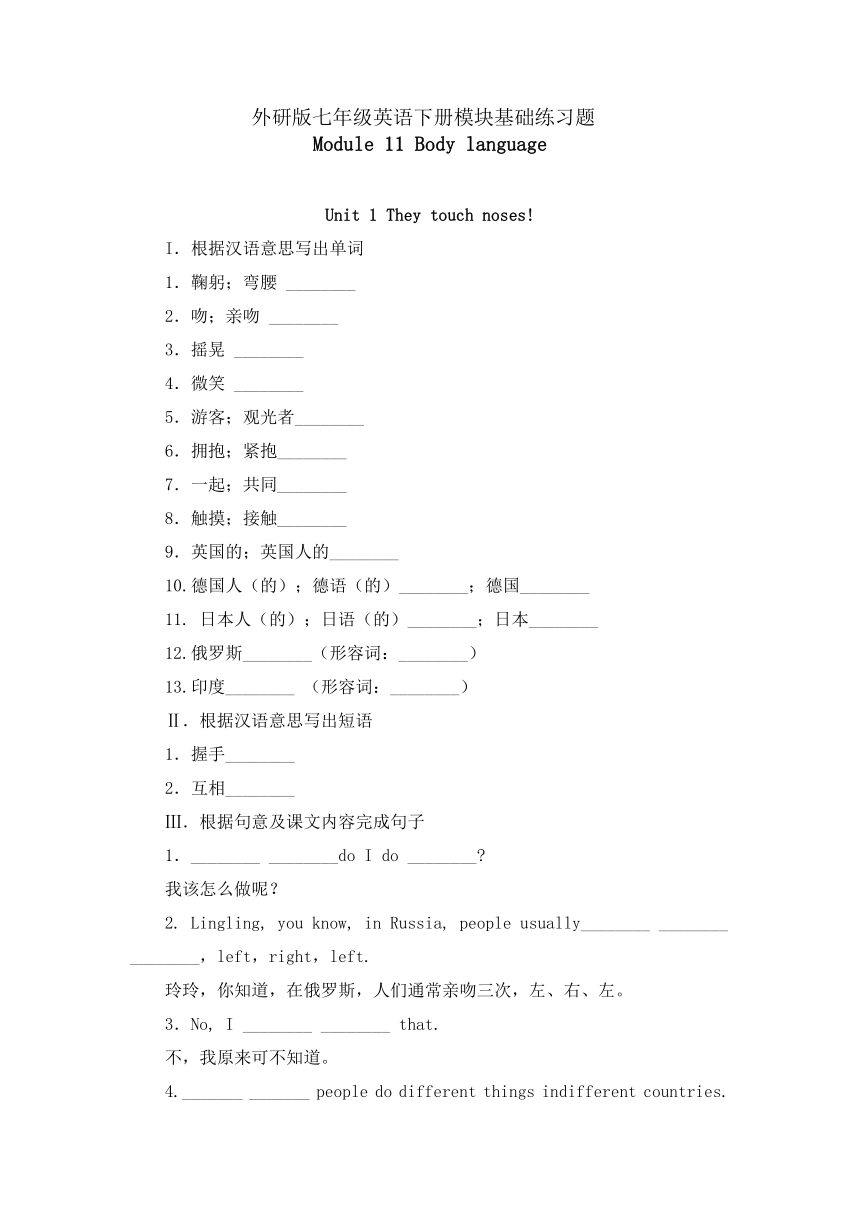 | |
| 格式 | docx | ||
| 文件大小 | 26.9KB | ||
| 资源类型 | 教案 | ||
| 版本资源 | 外研版 | ||
| 科目 | 英语 | ||
| 更新时间 | 2023-02-21 12:38:32 | ||
图片预览

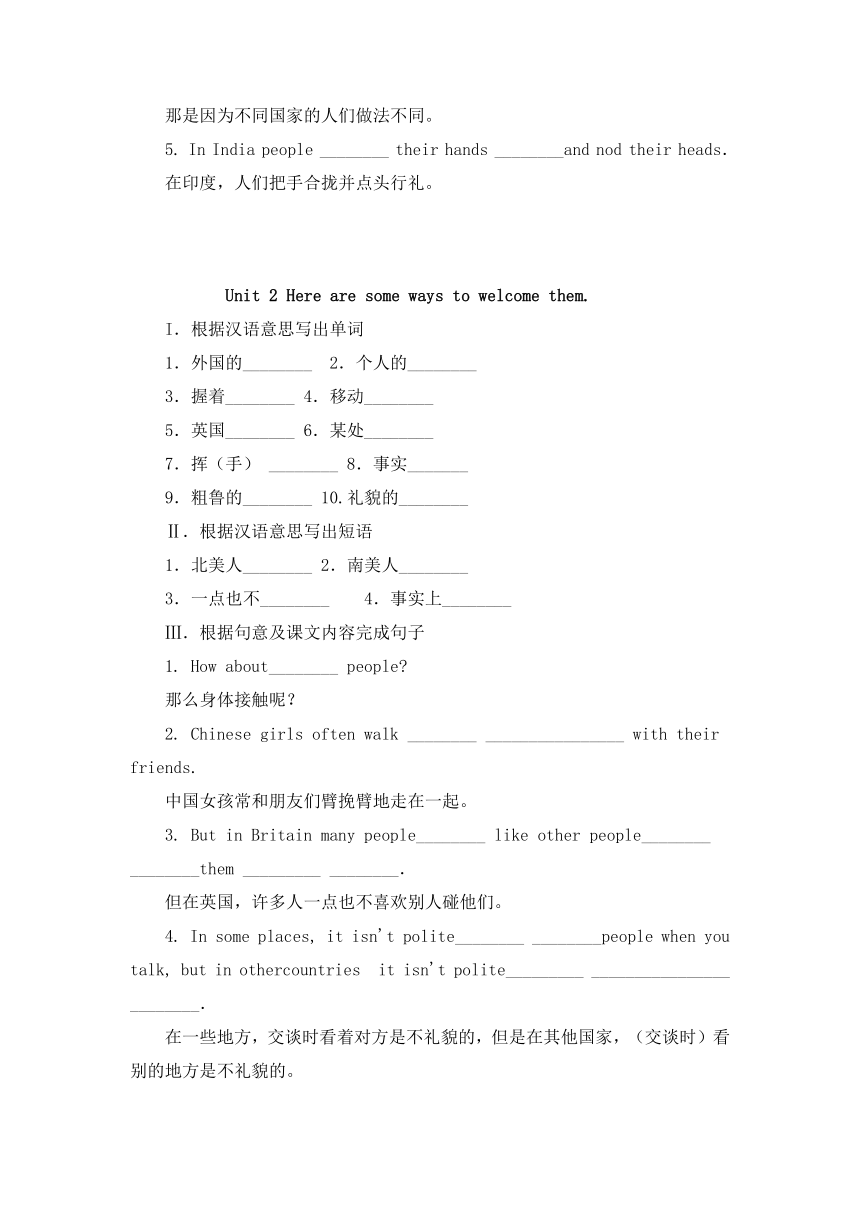
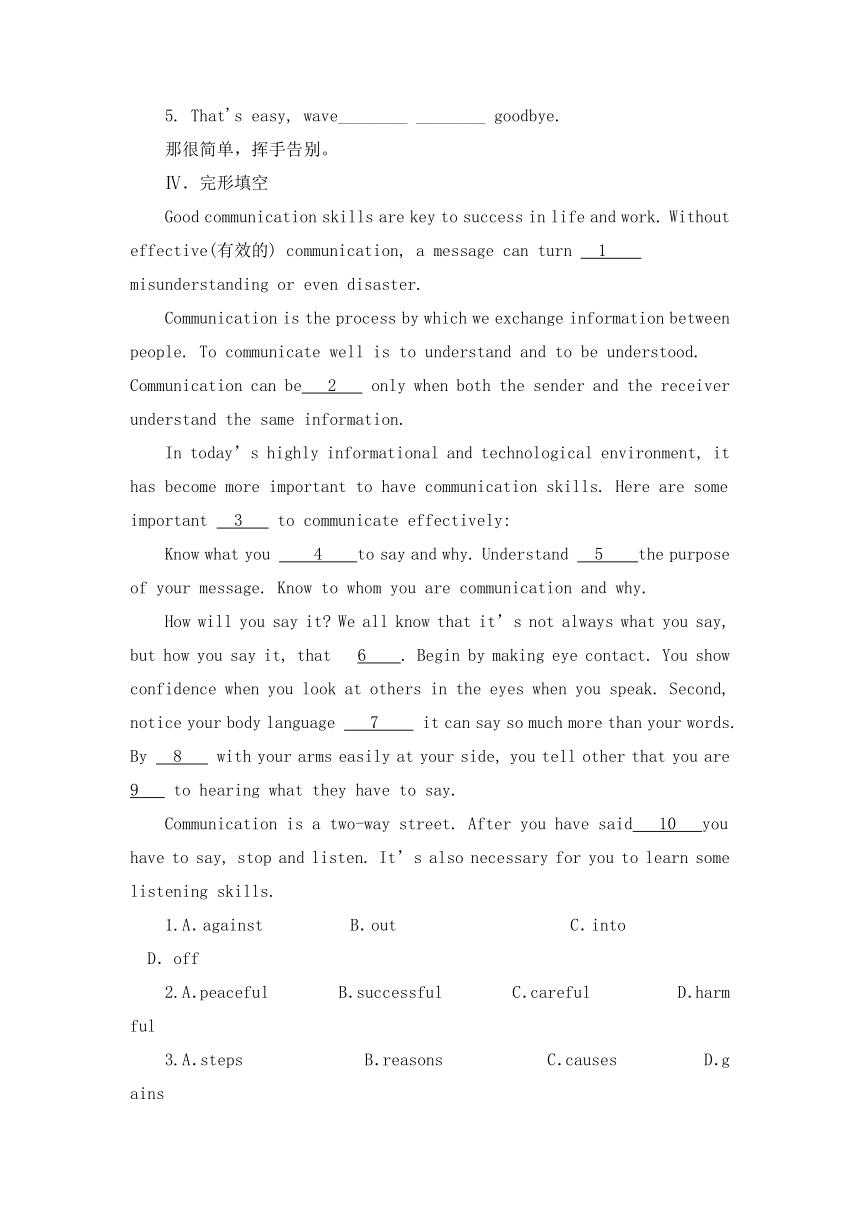
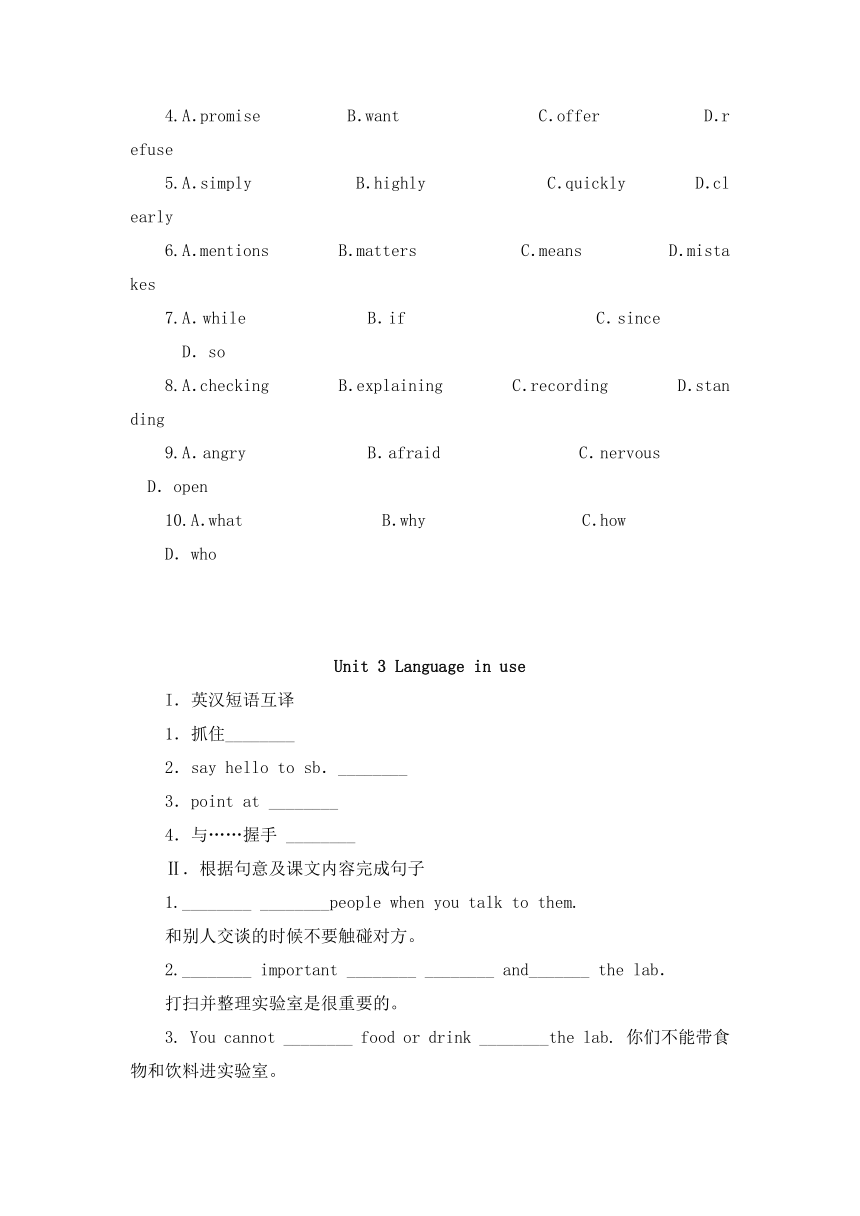
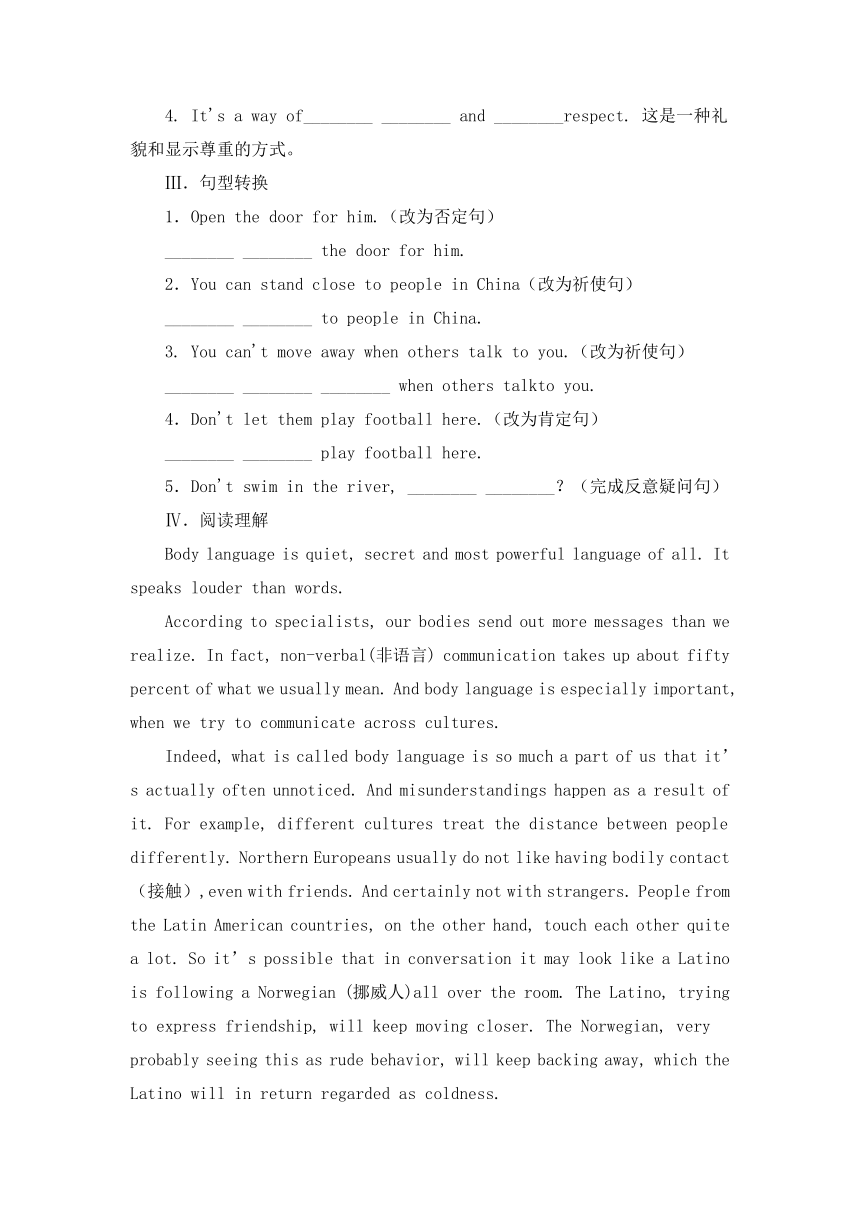
文档简介
外研版七年级英语下册模块基础练习题
Module 11 Body language
Unit 1 They touch noses!
I.根据汉语意思写出单词
1.鞠躬;弯腰 ________
2.吻;亲吻 ________
3.摇晃 ________
4.微笑 ________
5.游客;观光者________
6.拥抱;紧抱________
7.一起;共同________
8.触摸;接触________
9.英国的;英国人的________
10.德国人(的);德语(的)________;德国________
11. 日本人(的);日语(的)________;日本________
12.俄罗斯________(形容词:________)
13.印度________ (形容词:________)
Ⅱ.根据汉语意思写出短语
1.握手________
2.互相________
Ⅲ.根据句意及课文内容完成句子
1.________ ________do I do ________
我该怎么做呢?
2. Lingling, you know, in Russia, people usually________ ________ ________,left,right,left.
玲玲,你知道,在俄罗斯,人们通常亲吻三次,左、右、左。
3.No, I ________ ________ that.
不,我原来可不知道。
4._______ _______ people do different things indifferent countries.
那是因为不同国家的人们做法不同。
5. In India people ________ their hands ________and nod their heads.
在印度,人们把手合拢并点头行礼。
Unit 2 Here are some ways to welcome them.
I.根据汉语意思写出单词
1.外国的________ 2.个人的________
3.握着________ 4.移动________
5.英国________ 6.某处________
7.挥(手) ________ 8.事实_______
9.粗鲁的________ 10.礼貌的________
Ⅱ.根据汉语意思写出短语
1.北美人________ 2.南美人________
3.一点也不________ 4.事实上________
Ⅲ.根据句意及课文内容完成句子
1. How about________ people
那么身体接触呢?
2. Chinese girls often walk ________ ________________ with their friends.
中国女孩常和朋友们臂挽臂地走在一起。
3. But in Britain many people________ like other people________ ________them _________ ________.
但在英国,许多人一点也不喜欢别人碰他们。
4. In some places, it isn't polite________ ________people when you talk, but in othercountries it isn't polite_________ ________________ ________.
在一些地方,交谈时看着对方是不礼貌的,但是在其他国家,(交谈时)看别的地方是不礼貌的。
5. That's easy, wave________ ________ goodbye.
那很简单,挥手告别。
Ⅳ.完形填空
Good communication skills are key to success in life and work. Without effective(有效的) communication, a message can turn 1 misunderstanding or even disaster.
Communication is the process by which we exchange information between people. To communicate well is to understand and to be munication can be 2 only when both the sender and the receiver understand the same information.
In today’s highly informational and technological environment, it has become more important to have communication skills. Here are some important 3 to communicate effectively:
Know what you 4 to say and why. Understand 5 the purpose of your message. Know to whom you are communication and why.
How will you say it We all know that it’s not always what you say, but how you say it, that 6 . Begin by making eye contact. You show confidence when you look at others in the eyes when you speak. Second, notice your body language 7 it can say so much more than your words. By 8 with your arms easily at your side, you tell other that you are 9 to hearing what they have to say.
Communication is a two-way street. After you have said 10 you have to say, stop and listen. It’s also necessary for you to learn some listening skills.
1.A.against B.out C.into D.off
2.A.peaceful B.successful C.careful D.harmful
3.A.steps B.reasons C.causes D.gains
4.A.promise B.want C.offer D.refuse
5.A.simply B.highly C.quickly D.clearly
6.A.mentions B.matters C.means D.mistakes
7.A.while B.if C.since D.so
8.A.checking B.explaining C.recording D.standing
9.A.angry B.afraid C.nervous D.open
10.A.what B.why C.how D.who
Unit 3 Language in use
I.英汉短语互译
1.抓住________
2.say hello to sb.________
3.point at ________
4.与……握手 ________
Ⅱ.根据句意及课文内容完成句子
1.________ ________people when you talk to them.
和别人交谈的时候不要触碰对方。
2.________ important ________ ________ and_______ the lab.
打扫并整理实验室是很重要的。
3. You cannot ________ food or drink ________the lab. 你们不能带食物和饮料进实验室。
4. It's a way of________ ________ and ________respect. 这是一种礼貌和显示尊重的方式。
Ⅲ.句型转换
1.Open the door for him.(改为否定句)
________ ________ the door for him.
2.You can stand close to people in China(改为祈使句)
________ ________ to people in China.
3. You can't move away when others talk to you.(改为祈使句)
________ ________ ________ when others talkto you.
4.Don't let them play football here.(改为肯定句)
________ ________ play football here.
5.Don't swim in the river, ________ ________?(完成反意疑问句)
Ⅳ.阅读理解
Body language is quiet, secret and most powerful language of all. It speaks louder than words.
According to specialists, our bodies send out more messages than we realize. In fact, non-verbal(非语言) communication takes up about fifty percent of what we usually mean. And body language is especially important, when we try to communicate across cultures.
Indeed, what is called body language is so much a part of us that it’s actually often unnoticed. And misunderstandings happen as a result of it. For example, different cultures treat the distance between people differently. Northern Europeans usually do not like having bodily contact(接触),even with friends. And certainly not with strangers. People from the Latin American countries, on the other hand, touch each other quite a lot. So it’s possible that in conversation it may look like a Latino is following a Norwegian (挪威人)all over the room. The Latino, trying to express friendship, will keep moving closer. The Norwegian, very probably seeing this as rude behavior, will keep backing away, which the Latino will in return regarded as coldness.
Obviously, a great deal is going on when people talk. And only a part of it is in the words themselves. And when parties are from different cultures, there’s a strong possibility of misunderstanding. But whatever the situation is, the best advice is to obey the golden rule: Treat others as you would like to be treated.
1.You may find the passage in _____.
A, a science magazine B. a guide book
C. a sports newspaper D. a story book
2.The underlined word this in paragraph 3 refers to ___.
A. the Norwegian keeps moving closer
B. the Latino follows the Norwegian
C. the Norwegian keeps backing away
D. the Latino’s way of expressing friendship
3.Misunderstanding of body languages always happens because of the ___.
A. languages B. friends
C. cultures D. countries
4.Which of the following is true
A. people around the world have the same body languages
B. body language takes up about 50% of our communication
C. body language is the most important in our communication
D. body language is important when trying to communicate across cultures
5.If a foreign friend gives a hug to you, you should___.
A. shake hands with him B. give him a hug
C. refuse him D. kiss him
外研版七年级英语下册模块基础练习题
Module 11 Body language
Unit 1 They touch noses!
I.根据汉语意思写出单词
1.鞠躬;弯腰 ________
2.吻;亲吻 ________
3.摇晃 ________
4.微笑 ________
5.游客;观光者________
6.拥抱;紧抱________
7.一起;共同________
8.触摸;接触________
9.英国的;英国人的________
10.德国人(的);德语(的)________;德国________
11. 日本人(的);日语(的)________;日本________
12.俄罗斯________(形容词:________)
13.印度________ (形容词:________)
Ⅱ.根据汉语意思写出短语
1.握手________
2.互相________
Ⅲ.根据句意及课文内容完成句子
1.________ ________do I do ________
我该怎么做呢?
2. Lingling, you know, in Russia, people usually________ ________ ________,left,right,left.
玲玲,你知道,在俄罗斯,人们通常亲吻三次,左、右、左。
3.No, I ________ ________ that.
不,我原来可不知道。
4._______ _______ people do different things indifferent countries.
那是因为不同国家的人们做法不同。
5. In India people ________ their hands ________and nod their heads.
在印度,人们把手合拢并点头行礼。
参考答案
I. 1. bow 2. kiss 3. shake 4. smile 5. visitor 6. hug
7. together 8.touch 9.British 10. German; Germany
11. Japanese; Japan 12. Russia, Russian 13. India, Indian
Ⅱ.1. shake hands 2.each other
Ⅲ.1. How, that 2. kiss three times 3. didn't know4. That's because 5. put, together
Unit 2 Here are some ways to welcome them.
I.根据汉语意思写出单词
1.外国的________ 2.个人的________
3.握着________ 4.移动________
5.英国________ 6.某处________
7.挥(手) ________ 8.事实_______
9.粗鲁的________ 10.礼貌的________
Ⅱ.根据汉语意思写出短语
1.北美人________ 2.南美人________
3.一点也不________ 4.事实上________
Ⅲ.根据句意及课文内容完成句子
1. How about________ people
那么身体接触呢?
2. Chinese girls often walk ________ ________________ with their friends.
中国女孩常和朋友们臂挽臂地走在一起。
3. But in Britain many people________ like other people________ ________them _________ ________.
但在英国,许多人一点也不喜欢别人碰他们。
4. In some places, it isn't polite________ ________people when you talk, but in othercountries it isn't polite_________ ________________ ________.
在一些地方,交谈时看着对方是不礼貌的,但是在其他国家,(交谈时)看别的地方是不礼貌的。
5. That's easy, wave________ ________ goodbye.
那很简单,挥手告别。
Ⅳ.完形填空
Good communication skills are key to success in life and work. Without effective(有效的) communication, a message can turn 1 misunderstanding or even disaster.
Communication is the process by which we exchange information between people. To communicate well is to understand and to be munication can be 2 only when both the sender and the receiver understand the same information.
In today’s highly informational and technological environment, it has become more important to have communication skills. Here are some important 3 to communicate effectively:
Know what you 4 to say and why. Understand 5 the purpose of your message. Know to whom you are communication and why.
How will you say it We all know that it’s not always what you say, but how you say it, that 6 . Begin by making eye contact. You show confidence when you look at others in the eyes when you speak. Second, notice your body language 7 it can say so much more than your words. By 8 with your arms easily at your side, you tell other that you are 9 to hearing what they have to say.
Communication is a two-way street. After you have said 10 you have to say, stop and listen. It’s also necessary for you to learn some listening skills.
1.A.against B.out C.into D.off
2.A.peaceful B.successful C.careful D.harmful
3.A.steps B.reasons C.causes D.gains
4.A.promise B.want C.offer D.refuse
5.A.simply B.highly C.quickly D.clearly
6.A.mentions B.matters C.means D.mistakes
7.A.while B.if C.since D.so
8.A.checking B.explaining C.recording D.standing
9.A.angry B.afraid C.nervous D.open
10.A.what B.why C.how D.who
参考答案
I. 1. foreign 2. personal 3. hold 4. move 5. Britain
6. somewhere 7. wave 8. fact 9. rude 10. polite
Ⅱ.1. North American 2.South American 3.not at all4.in fact
Ⅲ.1. touching 2.arm in arm 3.don't, to touch, at all4. to look at, to look somewhere else 5. to say
Ⅳ.CBABD BCDDA
Unit 3 Language in use
I.英汉短语互译
1.抓住________
2.say hello to sb.________
3.point at ________
4.与……握手 ________
Ⅱ.根据句意及课文内容完成句子
1.________ ________people when you talk to them.
和别人交谈的时候不要触碰对方。
2.________ important ________ ________ and_______ the lab.
打扫并整理实验室是很重要的。
3. You cannot ________ food or drink ________the lab. 你们不能带食物和饮料进实验室。
4. It's a way of________ ________ and ________respect. 这是一种礼貌和显示尊重的方式。
Ⅲ.句型转换
1.Open the door for him.(改为否定句)
________ ________ the door for him.
2.You can stand close to people in China(改为祈使句)
________ ________ to people in China.
3. You can't move away when others talk to you.(改为祈使句)
________ ________ ________ when others talkto you.
4.Don't let them play football here.(改为肯定句)
________ ________ play football here.
5.Don't swim in the river, ________ ________?(完成反意疑问句)
Ⅳ.阅读理解
Body language is quiet, secret and most powerful language of all. It speaks louder than words.
According to specialists, our bodies send out more messages than we realize. In fact, non-verbal(非语言) communication takes up about fifty percent of what we usually mean. And body language is especially important, when we try to communicate across cultures.
Indeed, what is called body language is so much a part of us that it’s actually often unnoticed. And misunderstandings happen as a result of it. For example, different cultures treat the distance between people differently. Northern Europeans usually do not like having bodily contact(接触),even with friends. And certainly not with strangers. People from the Latin American countries, on the other hand, touch each other quite a lot. So it’s possible that in conversation it may look like a Latino is following a Norwegian (挪威人)all over the room. The Latino, trying to express friendship, will keep moving closer. The Norwegian, very probably seeing this as rude behavior, will keep backing away, which the Latino will in return regarded as coldness.
Obviously, a great deal is going on when people talk. And only a part of it is in the words themselves. And when parties are from different cultures, there’s a strong possibility of misunderstanding. But whatever the situation is, the best advice is to obey the golden rule: Treat others as you would like to be treated.
1.You may find the passage in _____.
A, a science magazine B. a guide book
C. a sports newspaper D. a story book
2.The underlined word this in paragraph 3 refers to ___.
A. the Norwegian keeps moving closer
B. the Latino follows the Norwegian
C. the Norwegian keeps backing away
D. the Latino’s way of expressing friendship
3.Misunderstanding of body languages always happens because of the ___.
A. languages B. friends
C. cultures D. countries
4.Which of the following is true
A. people around the world have the same body languages
B. body language takes up about 50% of our communication
C. body language is the most important in our communication
D. body language is important when trying to communicate across cultures
5.If a foreign friend gives a hug to you, you should___.
A. shake hands with him B. give him a hug
C. refuse him D. kiss him
参考答案
I.1.hold on to 2.向某人问好 3.指着4.shake hands with
Ⅱ.1. Don't touch 2. It's, to clean, tidy 3. bring, into4. being polite, showing
Ⅲ.1.Don't open 2.Stand close 3.Don't move away 4. Let them
5.will you
Ⅳ.ADCDB
Module 11 Body language
Unit 1 They touch noses!
I.根据汉语意思写出单词
1.鞠躬;弯腰 ________
2.吻;亲吻 ________
3.摇晃 ________
4.微笑 ________
5.游客;观光者________
6.拥抱;紧抱________
7.一起;共同________
8.触摸;接触________
9.英国的;英国人的________
10.德国人(的);德语(的)________;德国________
11. 日本人(的);日语(的)________;日本________
12.俄罗斯________(形容词:________)
13.印度________ (形容词:________)
Ⅱ.根据汉语意思写出短语
1.握手________
2.互相________
Ⅲ.根据句意及课文内容完成句子
1.________ ________do I do ________
我该怎么做呢?
2. Lingling, you know, in Russia, people usually________ ________ ________,left,right,left.
玲玲,你知道,在俄罗斯,人们通常亲吻三次,左、右、左。
3.No, I ________ ________ that.
不,我原来可不知道。
4._______ _______ people do different things indifferent countries.
那是因为不同国家的人们做法不同。
5. In India people ________ their hands ________and nod their heads.
在印度,人们把手合拢并点头行礼。
Unit 2 Here are some ways to welcome them.
I.根据汉语意思写出单词
1.外国的________ 2.个人的________
3.握着________ 4.移动________
5.英国________ 6.某处________
7.挥(手) ________ 8.事实_______
9.粗鲁的________ 10.礼貌的________
Ⅱ.根据汉语意思写出短语
1.北美人________ 2.南美人________
3.一点也不________ 4.事实上________
Ⅲ.根据句意及课文内容完成句子
1. How about________ people
那么身体接触呢?
2. Chinese girls often walk ________ ________________ with their friends.
中国女孩常和朋友们臂挽臂地走在一起。
3. But in Britain many people________ like other people________ ________them _________ ________.
但在英国,许多人一点也不喜欢别人碰他们。
4. In some places, it isn't polite________ ________people when you talk, but in othercountries it isn't polite_________ ________________ ________.
在一些地方,交谈时看着对方是不礼貌的,但是在其他国家,(交谈时)看别的地方是不礼貌的。
5. That's easy, wave________ ________ goodbye.
那很简单,挥手告别。
Ⅳ.完形填空
Good communication skills are key to success in life and work. Without effective(有效的) communication, a message can turn 1 misunderstanding or even disaster.
Communication is the process by which we exchange information between people. To communicate well is to understand and to be munication can be 2 only when both the sender and the receiver understand the same information.
In today’s highly informational and technological environment, it has become more important to have communication skills. Here are some important 3 to communicate effectively:
Know what you 4 to say and why. Understand 5 the purpose of your message. Know to whom you are communication and why.
How will you say it We all know that it’s not always what you say, but how you say it, that 6 . Begin by making eye contact. You show confidence when you look at others in the eyes when you speak. Second, notice your body language 7 it can say so much more than your words. By 8 with your arms easily at your side, you tell other that you are 9 to hearing what they have to say.
Communication is a two-way street. After you have said 10 you have to say, stop and listen. It’s also necessary for you to learn some listening skills.
1.A.against B.out C.into D.off
2.A.peaceful B.successful C.careful D.harmful
3.A.steps B.reasons C.causes D.gains
4.A.promise B.want C.offer D.refuse
5.A.simply B.highly C.quickly D.clearly
6.A.mentions B.matters C.means D.mistakes
7.A.while B.if C.since D.so
8.A.checking B.explaining C.recording D.standing
9.A.angry B.afraid C.nervous D.open
10.A.what B.why C.how D.who
Unit 3 Language in use
I.英汉短语互译
1.抓住________
2.say hello to sb.________
3.point at ________
4.与……握手 ________
Ⅱ.根据句意及课文内容完成句子
1.________ ________people when you talk to them.
和别人交谈的时候不要触碰对方。
2.________ important ________ ________ and_______ the lab.
打扫并整理实验室是很重要的。
3. You cannot ________ food or drink ________the lab. 你们不能带食物和饮料进实验室。
4. It's a way of________ ________ and ________respect. 这是一种礼貌和显示尊重的方式。
Ⅲ.句型转换
1.Open the door for him.(改为否定句)
________ ________ the door for him.
2.You can stand close to people in China(改为祈使句)
________ ________ to people in China.
3. You can't move away when others talk to you.(改为祈使句)
________ ________ ________ when others talkto you.
4.Don't let them play football here.(改为肯定句)
________ ________ play football here.
5.Don't swim in the river, ________ ________?(完成反意疑问句)
Ⅳ.阅读理解
Body language is quiet, secret and most powerful language of all. It speaks louder than words.
According to specialists, our bodies send out more messages than we realize. In fact, non-verbal(非语言) communication takes up about fifty percent of what we usually mean. And body language is especially important, when we try to communicate across cultures.
Indeed, what is called body language is so much a part of us that it’s actually often unnoticed. And misunderstandings happen as a result of it. For example, different cultures treat the distance between people differently. Northern Europeans usually do not like having bodily contact(接触),even with friends. And certainly not with strangers. People from the Latin American countries, on the other hand, touch each other quite a lot. So it’s possible that in conversation it may look like a Latino is following a Norwegian (挪威人)all over the room. The Latino, trying to express friendship, will keep moving closer. The Norwegian, very probably seeing this as rude behavior, will keep backing away, which the Latino will in return regarded as coldness.
Obviously, a great deal is going on when people talk. And only a part of it is in the words themselves. And when parties are from different cultures, there’s a strong possibility of misunderstanding. But whatever the situation is, the best advice is to obey the golden rule: Treat others as you would like to be treated.
1.You may find the passage in _____.
A, a science magazine B. a guide book
C. a sports newspaper D. a story book
2.The underlined word this in paragraph 3 refers to ___.
A. the Norwegian keeps moving closer
B. the Latino follows the Norwegian
C. the Norwegian keeps backing away
D. the Latino’s way of expressing friendship
3.Misunderstanding of body languages always happens because of the ___.
A. languages B. friends
C. cultures D. countries
4.Which of the following is true
A. people around the world have the same body languages
B. body language takes up about 50% of our communication
C. body language is the most important in our communication
D. body language is important when trying to communicate across cultures
5.If a foreign friend gives a hug to you, you should___.
A. shake hands with him B. give him a hug
C. refuse him D. kiss him
外研版七年级英语下册模块基础练习题
Module 11 Body language
Unit 1 They touch noses!
I.根据汉语意思写出单词
1.鞠躬;弯腰 ________
2.吻;亲吻 ________
3.摇晃 ________
4.微笑 ________
5.游客;观光者________
6.拥抱;紧抱________
7.一起;共同________
8.触摸;接触________
9.英国的;英国人的________
10.德国人(的);德语(的)________;德国________
11. 日本人(的);日语(的)________;日本________
12.俄罗斯________(形容词:________)
13.印度________ (形容词:________)
Ⅱ.根据汉语意思写出短语
1.握手________
2.互相________
Ⅲ.根据句意及课文内容完成句子
1.________ ________do I do ________
我该怎么做呢?
2. Lingling, you know, in Russia, people usually________ ________ ________,left,right,left.
玲玲,你知道,在俄罗斯,人们通常亲吻三次,左、右、左。
3.No, I ________ ________ that.
不,我原来可不知道。
4._______ _______ people do different things indifferent countries.
那是因为不同国家的人们做法不同。
5. In India people ________ their hands ________and nod their heads.
在印度,人们把手合拢并点头行礼。
参考答案
I. 1. bow 2. kiss 3. shake 4. smile 5. visitor 6. hug
7. together 8.touch 9.British 10. German; Germany
11. Japanese; Japan 12. Russia, Russian 13. India, Indian
Ⅱ.1. shake hands 2.each other
Ⅲ.1. How, that 2. kiss three times 3. didn't know4. That's because 5. put, together
Unit 2 Here are some ways to welcome them.
I.根据汉语意思写出单词
1.外国的________ 2.个人的________
3.握着________ 4.移动________
5.英国________ 6.某处________
7.挥(手) ________ 8.事实_______
9.粗鲁的________ 10.礼貌的________
Ⅱ.根据汉语意思写出短语
1.北美人________ 2.南美人________
3.一点也不________ 4.事实上________
Ⅲ.根据句意及课文内容完成句子
1. How about________ people
那么身体接触呢?
2. Chinese girls often walk ________ ________________ with their friends.
中国女孩常和朋友们臂挽臂地走在一起。
3. But in Britain many people________ like other people________ ________them _________ ________.
但在英国,许多人一点也不喜欢别人碰他们。
4. In some places, it isn't polite________ ________people when you talk, but in othercountries it isn't polite_________ ________________ ________.
在一些地方,交谈时看着对方是不礼貌的,但是在其他国家,(交谈时)看别的地方是不礼貌的。
5. That's easy, wave________ ________ goodbye.
那很简单,挥手告别。
Ⅳ.完形填空
Good communication skills are key to success in life and work. Without effective(有效的) communication, a message can turn 1 misunderstanding or even disaster.
Communication is the process by which we exchange information between people. To communicate well is to understand and to be munication can be 2 only when both the sender and the receiver understand the same information.
In today’s highly informational and technological environment, it has become more important to have communication skills. Here are some important 3 to communicate effectively:
Know what you 4 to say and why. Understand 5 the purpose of your message. Know to whom you are communication and why.
How will you say it We all know that it’s not always what you say, but how you say it, that 6 . Begin by making eye contact. You show confidence when you look at others in the eyes when you speak. Second, notice your body language 7 it can say so much more than your words. By 8 with your arms easily at your side, you tell other that you are 9 to hearing what they have to say.
Communication is a two-way street. After you have said 10 you have to say, stop and listen. It’s also necessary for you to learn some listening skills.
1.A.against B.out C.into D.off
2.A.peaceful B.successful C.careful D.harmful
3.A.steps B.reasons C.causes D.gains
4.A.promise B.want C.offer D.refuse
5.A.simply B.highly C.quickly D.clearly
6.A.mentions B.matters C.means D.mistakes
7.A.while B.if C.since D.so
8.A.checking B.explaining C.recording D.standing
9.A.angry B.afraid C.nervous D.open
10.A.what B.why C.how D.who
参考答案
I. 1. foreign 2. personal 3. hold 4. move 5. Britain
6. somewhere 7. wave 8. fact 9. rude 10. polite
Ⅱ.1. North American 2.South American 3.not at all4.in fact
Ⅲ.1. touching 2.arm in arm 3.don't, to touch, at all4. to look at, to look somewhere else 5. to say
Ⅳ.CBABD BCDDA
Unit 3 Language in use
I.英汉短语互译
1.抓住________
2.say hello to sb.________
3.point at ________
4.与……握手 ________
Ⅱ.根据句意及课文内容完成句子
1.________ ________people when you talk to them.
和别人交谈的时候不要触碰对方。
2.________ important ________ ________ and_______ the lab.
打扫并整理实验室是很重要的。
3. You cannot ________ food or drink ________the lab. 你们不能带食物和饮料进实验室。
4. It's a way of________ ________ and ________respect. 这是一种礼貌和显示尊重的方式。
Ⅲ.句型转换
1.Open the door for him.(改为否定句)
________ ________ the door for him.
2.You can stand close to people in China(改为祈使句)
________ ________ to people in China.
3. You can't move away when others talk to you.(改为祈使句)
________ ________ ________ when others talkto you.
4.Don't let them play football here.(改为肯定句)
________ ________ play football here.
5.Don't swim in the river, ________ ________?(完成反意疑问句)
Ⅳ.阅读理解
Body language is quiet, secret and most powerful language of all. It speaks louder than words.
According to specialists, our bodies send out more messages than we realize. In fact, non-verbal(非语言) communication takes up about fifty percent of what we usually mean. And body language is especially important, when we try to communicate across cultures.
Indeed, what is called body language is so much a part of us that it’s actually often unnoticed. And misunderstandings happen as a result of it. For example, different cultures treat the distance between people differently. Northern Europeans usually do not like having bodily contact(接触),even with friends. And certainly not with strangers. People from the Latin American countries, on the other hand, touch each other quite a lot. So it’s possible that in conversation it may look like a Latino is following a Norwegian (挪威人)all over the room. The Latino, trying to express friendship, will keep moving closer. The Norwegian, very probably seeing this as rude behavior, will keep backing away, which the Latino will in return regarded as coldness.
Obviously, a great deal is going on when people talk. And only a part of it is in the words themselves. And when parties are from different cultures, there’s a strong possibility of misunderstanding. But whatever the situation is, the best advice is to obey the golden rule: Treat others as you would like to be treated.
1.You may find the passage in _____.
A, a science magazine B. a guide book
C. a sports newspaper D. a story book
2.The underlined word this in paragraph 3 refers to ___.
A. the Norwegian keeps moving closer
B. the Latino follows the Norwegian
C. the Norwegian keeps backing away
D. the Latino’s way of expressing friendship
3.Misunderstanding of body languages always happens because of the ___.
A. languages B. friends
C. cultures D. countries
4.Which of the following is true
A. people around the world have the same body languages
B. body language takes up about 50% of our communication
C. body language is the most important in our communication
D. body language is important when trying to communicate across cultures
5.If a foreign friend gives a hug to you, you should___.
A. shake hands with him B. give him a hug
C. refuse him D. kiss him
参考答案
I.1.hold on to 2.向某人问好 3.指着4.shake hands with
Ⅱ.1. Don't touch 2. It's, to clean, tidy 3. bring, into4. being polite, showing
Ⅲ.1.Don't open 2.Stand close 3.Don't move away 4. Let them
5.will you
Ⅳ.ADCDB
同课章节目录
- Module 1 Lost and found
- Unit 1 Whose bag is this?
- Unit 2 Are they yours?
- Unit 3 Language in use
- Module 2 What can you do ?
- Unit 1 I can play the piano
- Unit 2 I can run really fast
- Unit 3 Language in use
- Module 3 Making plans
- Unit 1 What are you going to do at the weekends?
- Unit 2 We're going to cheer the players.
- Unit 3 Language in use
- Module 4 Life in the future
- Unit 1 Everyone will study at home
- Unit 2 Every family will have a small plane.
- Unit 3 Language in use
- Module 5 Shopping
- Unit 1 What can I do for you?
- Unit 2 You can buy everything on the Internet
- Unit 3 Language in use
- Module 6 Around town
- Unit 1 Could you tell me how to get to the Nationa
- Unit 2 The London Eye is on your right.
- Unit 3 Language in use
- Revision module A
- Module 7 My past life
- Unit 1 I was born in a small village.
- Unit 2 I was born in Quincy.
- Unit 3 Language in use
- Module 8 Story time
- Unit 1 Once upon a time….
- Unit 2 Goldilocks hurried out of the house.
- Unit 3 Language in use
- Module 9 Life history
- Unit 1 He left school and began work at the age of
- Unit 2 He decided to be an actor.
- Unit 3 Language in use
- Module 10 A holiday journey
- Unit 1 What did you do?
- Unit 2 This morning we took a walk.
- Unit 3 Language in use
- Module 11 Body language
- Unit 1 They touch noses!
- Unit 2 Here are some ways to welcome them.
- Unit 3 Language in use
- Module 12 Western music
- Unit 1 It's so beautiful!
- Unit 2 Vienna is the centre of European classical
- Unit 3 Language in use
- Revision module B
